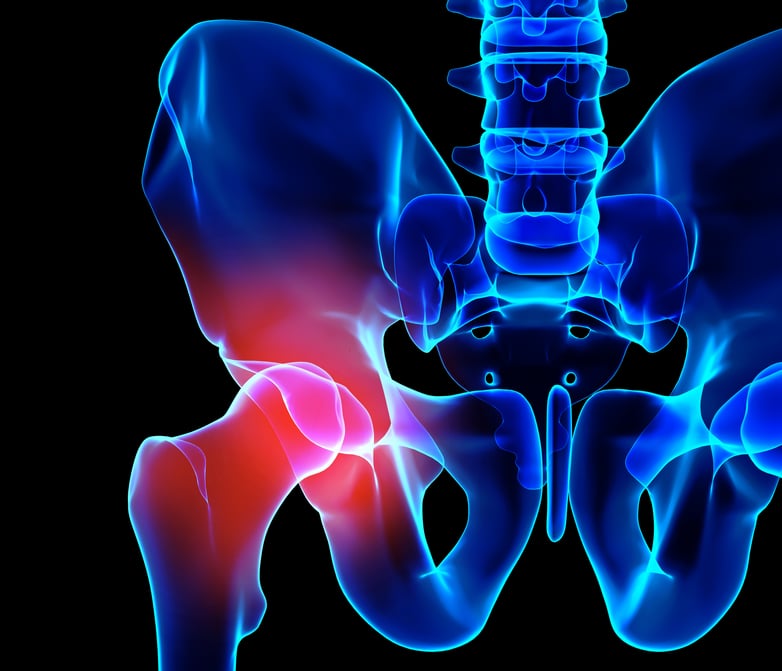 By E. Matthew Heinrich, M.D. • January 25, 2018
By E. Matthew Heinrich, M.D. • January 25, 2018
Understanding Total Hip Replacement
Why Total Hip Replacement?
More than 2.5 million Americans are living with an artificial hip, according to data from the American Academy of Orthopaedic Surgeons - that’s just under 1% of the U.S. population. The National Institutes of Health reports about 332,000 hip replacement surgeries are performed each year in the U.S., a number that’s increasing partly as a result of improvements in implant design and the surgical procedure itself, and partly because people are staying more active as they get older - and that means they’re more likely to experience hip pain and related symptoms that can’t be relieved by physical therapy and other non-invasive options.
As effective as hip replacement surgery can be in relieving painful symptoms and restoring joint function and mobility, many patients remain unsure of what the surgery entails and what they can expect during recovery and afterward. If you’re considering hip replacement surgery, here’s what you should know.
What Does Total Hip Replacement Surgery Do?
The goal of hip replacement surgery is to remove the damaged or diseased portions of the hip joint and replace them with artificial components designed to function in the same manner as the natural joint. The prosthesis includes two major components: one portion that covers the socket portion of the joint (the acetabulum) and one that’s inserted into the femur (the thigh bone) and includes a ball-shaped end that fits in the socket (or acetabulum). Some prostheses are cemented in place while others are designed to fuse with natural bone tissue over time, a process called osseointegration.
Hip replacement surgery can be a very good choice for patients who have chronic hip pain that interferes with normal daily activities and decreases their quality of life, including men and women with osteoarthritis and rheumatoid arthritis, traumatic injuries and bone tumors.
What Happens During Total Hip Replacement Surgery?
There are several approaches for hip replacement surgery, including a “traditional” approach that uses a large 6- to 8-inch incision and minimally-invasive approaches that use smaller incisions with the goal of less tissue damage, less bleeding, fewer complications and faster recovery. At Muve Lakeway, Dr. Dodgin and I are pioneers of the anterior approach for hip replacement, a minimally-invasive technique that uses small incisions to access and replace the diseased joint. In anterior hip replacement, special instruments are used to gently move muscles and other tissue aside instead of cutting through tissue. As a result, it’s possible for patients to experience far less post-op discomfort, and recovery in some cases can be much faster. Most procedures take less than two hours to perform.
What is Total Hip Replacement recovery like?
At Muve Lakeway, patients are discharged the same day as they have their surgery and encouraged to spend the first 2 post-operative days just upstairs from our ASC in the Muve Suites, a patient-optimized environment designed to help educate, monitor and support patients so that they can leave Muve Lakeway better prepared to continue their recovery at home. Once you’re “checked in” to the Muve Suites, our team will work with you to get you up and moving quickly and safely using physical therapy techniques designed to help promote healing and reduce post-op pain and stiffness. You’ll be continually monitored and evaluated, learning to take control of your own self-care so you feel confident and empowered once you return home.
After check-out, you’ll stay in touch with your care team on a regular basis to continue your custom rehab program, and you’ll also have online access to interactive, physician-directed rehab and therapy programs to provide you with support throughout your recovery process. And of course, our team will be with you every step of the way, answering your questions, discussing your concerns, and providing you with the guidance and support you need to ensure the fastest and most successful recovery.
How Active Can I Be After My Total Hip Replacement Surgery?
Recovering from joint replacement surgery requires patients to stay active within the parameters recommended by their surgeon. Staying active after surgery helps the joint components fuse while preventing the joint itself from becoming stiff. Movement also stimulates circulation and other processes necessary for complete and successful healing. At Muve, we work with patients who are motivated and willing to be active partners in their recovery, men and women who lead fairly active lifestyles and look forward to resuming their activities as they become adjusted to their new joint. Prior to surgery, you’ll be asked about your level of activity and the types of activities you enjoy. Once surgery is complete, our team will work closely with you to help you get back to your active lifestyle you enjoy.
Reading about hip replacement surgery is an important part of educating yourself about the procedure and the recovery process. But the best way to learn whether or not hip replacement surgery could be a good option for your needs is to talk directly with a skilled and experienced orthopedic surgeon. Getting started is simple. Visit MuveHealth.com and visit our Lakeway Location page to learn more about Dr. Dodgin and myself, two of Muve Lakeway's experienced affiliated physician partners.
*Professional Services are provided by independent physicians and not by Muve Health.
This blog post is not intended to be a substitute for professional medical advice, diagnosis, or treatment. Always seek the advice of your physician or other qualified health provider with any questions you might have regarding a medical condition.



